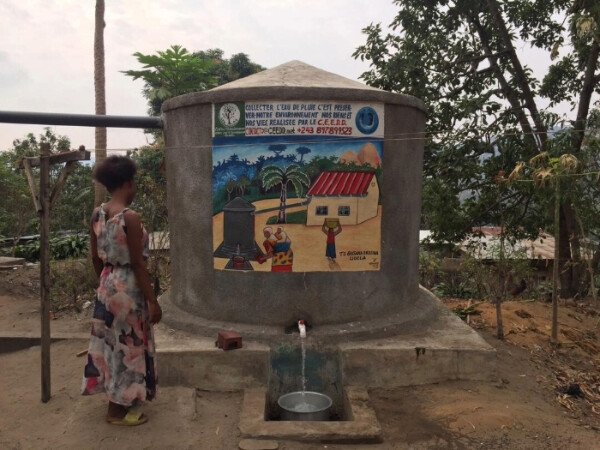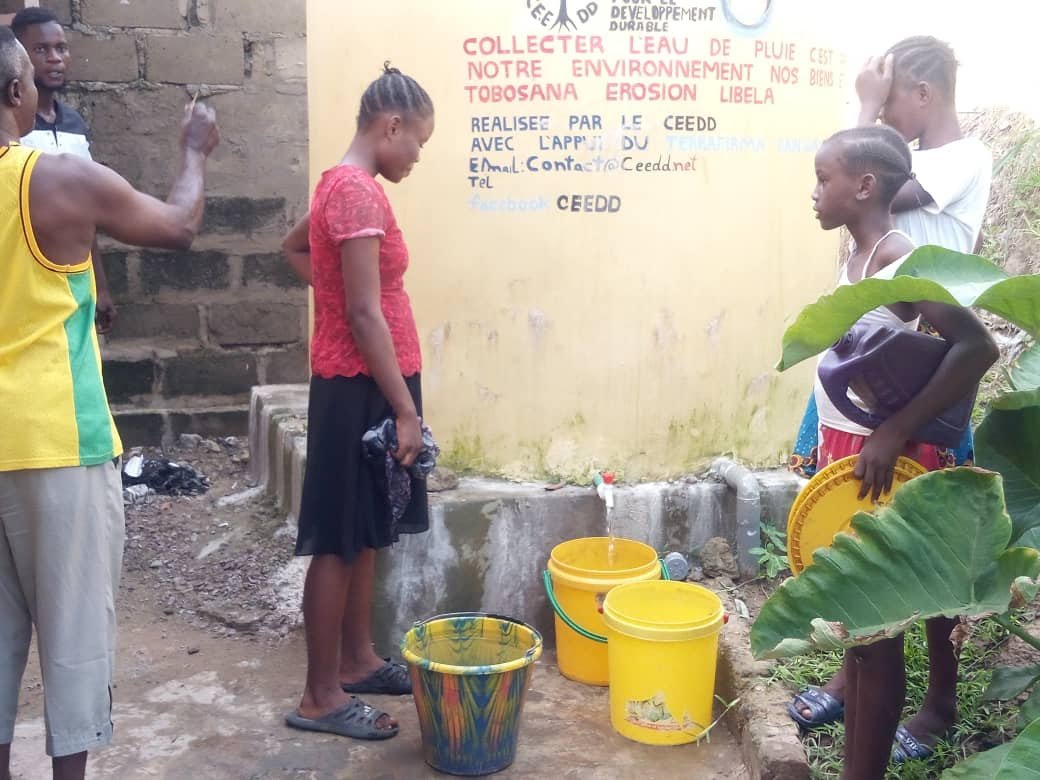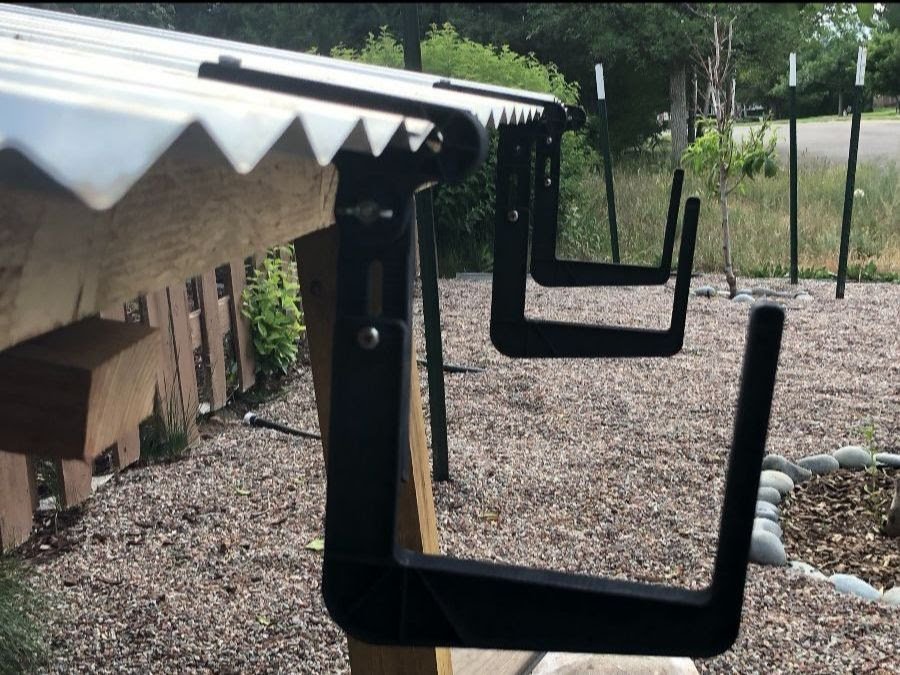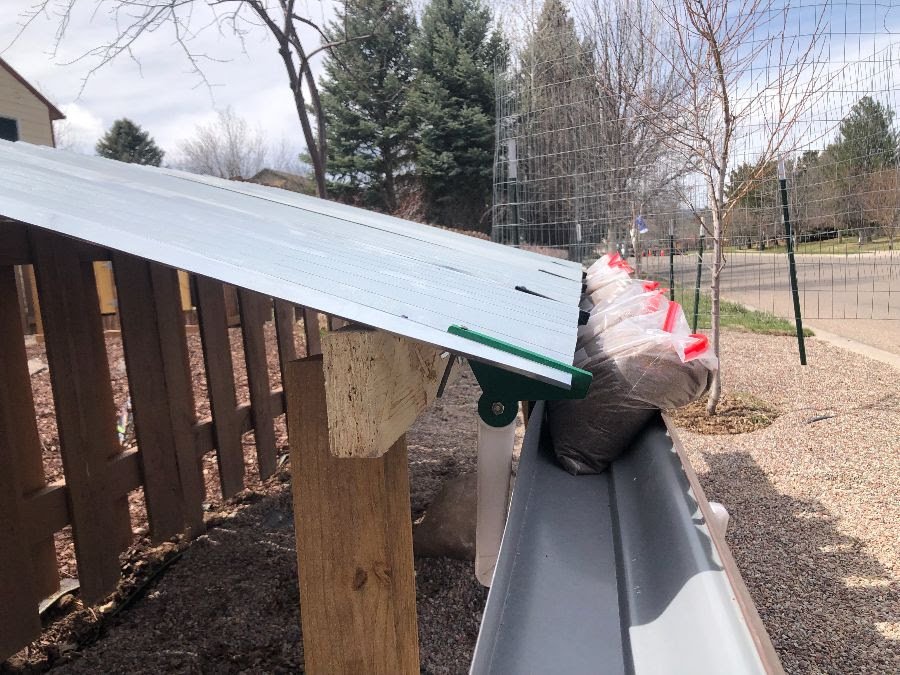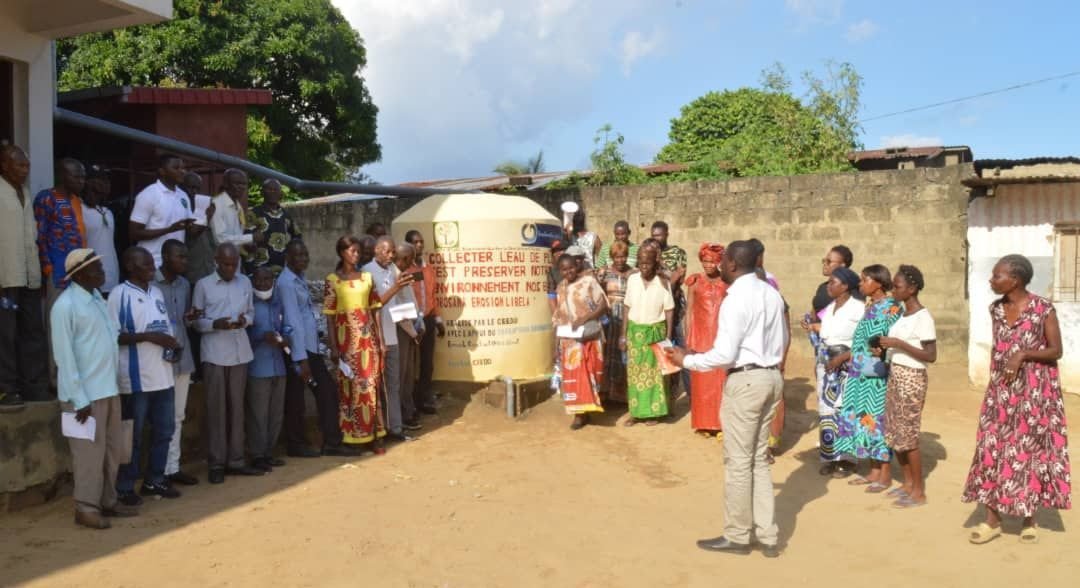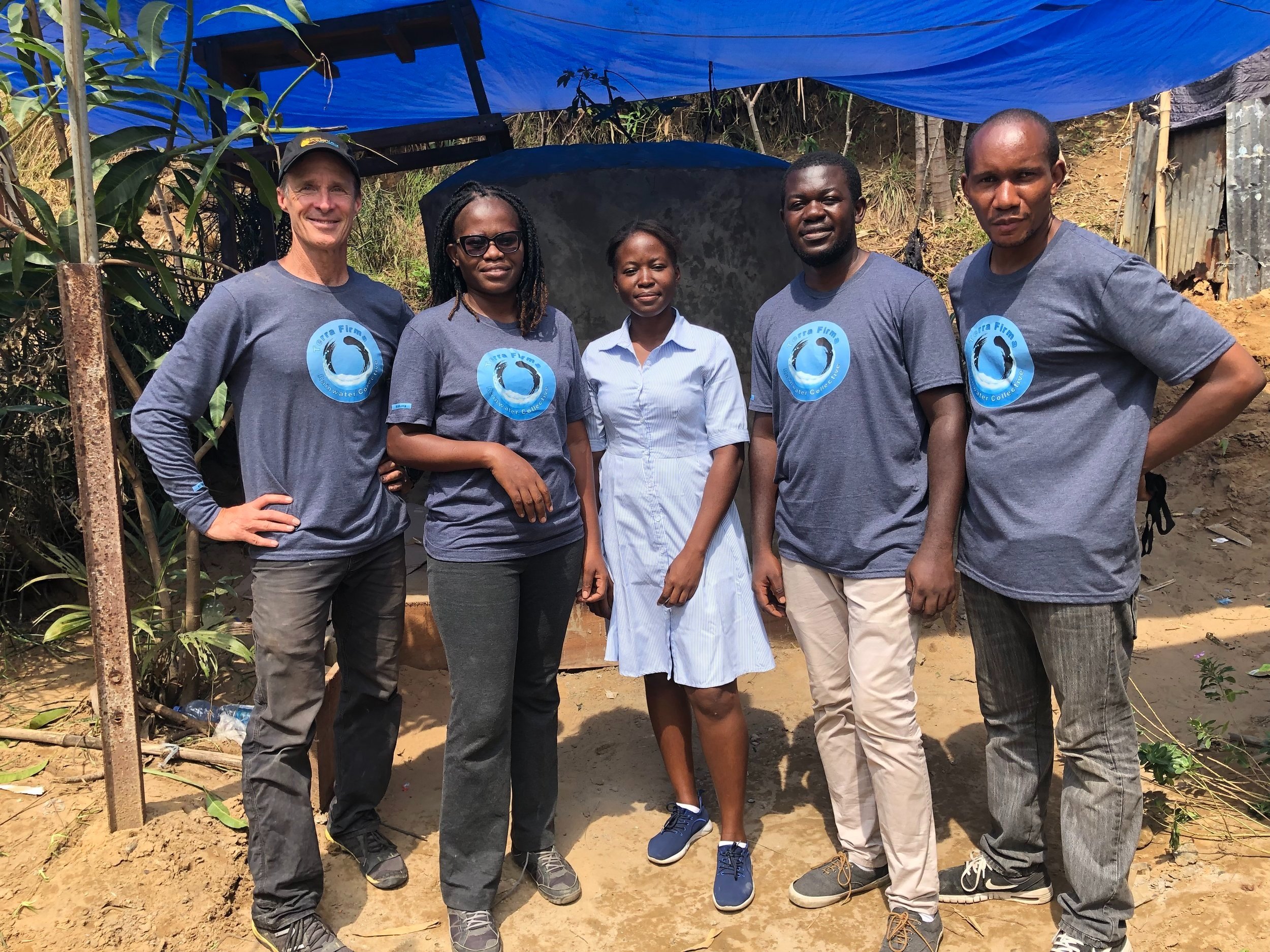
Field Updates
100 collection systems on the ground!
With the rainy season well under way, we are happy to report that we will meet 2023's goal and complete our 100th collection system in early January. Those will provide domestic water for about 800 residents. We have been fine tuning our process along the way and are now working in 10 different neighborhoods of Kinshasa to create that ‘social proof’ where residents can see and experience the benefits of capturing monsoon rains for domestic uses. The storage tanks range in size from 1,300 to 2,400 gallons. For a typical home in this climate, this translates to almost 9 months of domestic water and eliminates most of the daily/weekly trips to purchase and haul water from distant sources.
Since the beginning, our commitment is to the families and communities in need of fresh water and to those living with the threat of losing their home every time it rains. Each season we learn a little more and put that to use, making our systems accessible to those who need them most. Most importantly, we can see the difference we are making in people’s lives.
A new collection tank installed in Kinshasa in 2023.
In 2024, we will further scale our work and impact in highly visible communities and work with new partners to provide a foundation for exponential impact in the coming years. To that end, we've invested significant resources in the fabrication of an Injection Mold to mass produce our patented gutter clips - a key ingredient to our systems and success on the ground.
Injection Mold
The common roofing material in many developing countries, including Congo, is corrugated metal panels. Construction quality and techniques often don't make it easy to attach a gutter. This has limited people's ability to catch and store rainwater at any meaningful scale.
To address this issue, we developed and patented a thermoplastic clip that attaches directly to the metal roof panels and provides a hanger arm to hold a gutter. It is simple, affordable, and adjustable to roofs of any pitch. After two years of prototyping with 3-D prints, our partners gave the thumbs up - it was time to create an injection mold to cheaply mass produce the parts.
Who knew an injection mold for plastics was so complicated? These two pieces slide together to form the mold.
With the guidance of Suncast in Chicago, we solicited bids and commissioned an injection mold through CO WIN Plastics and Metal Company in Shenzhen, China. After production and shipping of the first 1,000 clips, the mold is on a boat back to Chicago for final inspection and larger production runs. In a little over 2 years, we have gone from concept to concept, to 3-D printed prototypes, to local testing and feedback, to an injection mold. We are now able to produce these clips for less than a dollar compared to our prototype 3-D printed clips that cost forty times that amount. The next step is working with African construction material suppliers to sell our clips, hopefully creating another revenue stream to financially sustain rainwater collection on the ground.
What’s next in 2024?
In 2024, the goal of our expanded phase is to complete installations at another 150 demonstration sites while developing awareness and distribution channels around our innovative roof clip. We are scaling at a pace that's just right for perfecting our processes, ensuring success for our in-country team, and amplifying our impact on the ground.
With each new system installed, we are shifting community values about rainwater collection systems. Our goal is for this city of millions to consider our solutions to be an integral component of any roof. We firmly believe that the best way to treat the next gulley is to prevent it from forming in the first place. We will continue to elevate concerns about groundwater pollution from the practice of filling eroding gullies with domestic and industrial garbage. There are currently around 600 of these impromptu landfills in Kinshasa alone, so we have developed a partnership with the University of Kinshasa to evaluate the long-term impacts to drinking water supplies from this short-term 'solution'. And we continue to work with UNOPS, World Bank, US Forest Service International Programs, and other global organizations to further our message and our reach.
We need you!
In an era of climate uncertainty, it’s hard to know how to make a real difference or how our individual and seemingly small efforts amount to real, meaningful change in the world, especially in developing countries where resources are scarce. The cost of a complete rainwater catchment system at a typical home in Kinshasa ranges from $700 - $900, a significant investment for these residents. Yet when we join our resources, our collective offering and impact is immense.
Terra Firma Rainwater Collective is making a measurable difference in the present lives and future opportunities of many, and with your help, the impact will continue growing. Please consider supporting this important work of transforming rainwater into opportunity. Check out our Fundrazr page for more details on how you can help.
Congo region sees majors floods and landslides
This news report from the New York Times provides additional information. According to the article, at least 141 people died in the Democratic Republic of Congo in December after heavy rains caused floods and landslides in the capital, Kinshasa. It was the latest in a series of deadly environmental disasters to hit West and Central African countries this year.
Many neighborhoods, major infrastructure and key roads were still underwater or in ruins after the previous day’s all-night downpour brought the worst floods in years to the city of 15 million people. Nearly 40,000 households were flooded and 280 collapsed, according to an official document seen by The New York Times.
An Overview of our Rainwater Catchment Systems
We hope this video gives you a rich introduction to our projects - an introduction words alone can't quite capture. Amazing work is happening in Kinshasa!
We've all heard the saying "it takes a village." It is 100% true for Terra Firma Rainwater Collective construction projects! From the generosity of your donations, to the dedication of our in-country partners, to the physical efforts of our homeowners and neighborhood volunteers - it takes many hands to complete a rainwater catchment system. Thank you for being part of the Terra Firma village.
Let's talk about the rain in Kinshasa
Experiencing the monsoon season in Central Africa is not possible for most of us, so the next best option is a deeper understanding of what it is like to live in Kinshasa. To this end, we have videos, news articles and some information to share. The story is powerful, the issues are complex, and solutions like rainwater catchment that harness the power of the rain are critical now more than ever.
This 2021 video report from NTV Kenya (See video below) includes footage of the monsoon’s impact as well as interviews with local residents describing the impact of the 2019 flooding.
During the monsoon season, one in three storms have 1-inch or more of rain. One in nine storms have 2-inches or more.
If rain is captured, the distribution patterns and amount of rain that falls can provide a typical household with water for nine months of the year
Redirecting the weekly cost of purchasing water, homeowners can finance a complete rainwater catchment system in 24-30 months.
The average American uses 82 gallons of water per day while a typical resident of Congo might use 6 gallons (20 liters).
Look what happened in 2022!
We are excited to report that Terra Firma Rainwater Collective has completed construction of twenty-five rainwater catchment systems in Kinshasa, Democratic Republic of Congo. These pilot sites collect water from individual homes as well as buildings with much larger roofs, such as churches and schools. The storage tanks range in sizes from 3,000 to 9,000 liters (~800 to ~2400 gallons). For a typical home, this translates to almost 9 months of domestic water and eliminates most of the daily/weekly trips to purchase and haul water from distant sources. For schools and churches, this means transforming large roof runoff from a liability to a high-profile shared community water resource.
Rain in Kinshasa comes downs with a vengeance. To simulate this impact, we test our catchment systems by loading sandbags on our test roof affixed with our patented roof clips. Our ‘sandbag deluges’ yield immediate feedback on how to refine our roof clip design, in particular how to distribute the weight of collected water and accommodate more slope on the gutter. We are excited to share that our second batch of prototype clips are being installed in Kinshasa as you read this!
We have expanded our in-country staff! We are pleased to have two full-time staff responsible for site selection and construction logistics management. We also have two part-time staff engaging in community outreach and education. Our in-country partners live and work in the communities we serve, a critical component of our success in these neighborhoods.
We are now working in three different communities in Kinshasa, and the completion of each site generates more and more interest among neighbors. This is exactly the snowball effect we have been counting on. We have selected a higher income neighborhood to test a reimbursement model where residents with the ability to contribute funds toward the cost of installation help subsidize those with fewer resources.
We hope you are feeling excited and inspired with the progress Terra Firma Rainwater Collective has made in 2022. We certainly are! Our annual fundraising campaign kicks off on Giving Tuesday (11/29). We look forward to sharing more news in the coming weeks and hope we can count on your support!
Thanks again for being part of our team. Together we are changing lives, one roof at a time.
Terra Firma selected for UN Award Program!
We are excited to announce that Terra Firma has been been awarded a place in the UNOPS S3i Startup Incubation Program for 2022. After competing against 800+ innovators, entrepreneurs and start-ups, Terra Firma was selected to take place in a one-year program based out of Malmo, Sweden designed to develop innovative solutions to help build sustainable, resilient and inclusive cities and communities across the globe.
As an integral member of the United Nations, UNOPS supports efforts to bring peace and security, humanitarian and development solutions to some of the world’s most challenging environments. The UNOPS Sustainable Investments in Infrastructure and Innovation (S3i) initiative launched the Global Innovation Challenge and its Incubation Program recently, with much of these efforts focusing on enhancing community resilience to the impacts of climate change and advancing gender equality. Terra Firma’s mission was a complete fit with this program.
The goal of the Incubation Program is to provide organizations like Terra Firma with support to advance our marketplace opportunities and solutions, connect us with communities in need, and connect us to financing and donor networks around the world.
Acceptance into this program may significantly increase Terra Firma's international exposure and help us determine critical next steps as we develop strategies to ramp up and scale our solutions on the ground. Through this award, Terra Firma will gain access to:
UNOPS S3i Innovation networks (MIT and other universities, global business partners, think tanks, and entrepreneurs) sharing international expertise;
UNOPS country offices and pilot programs in the field;
Incubation space and learning opportunities at the UNOPS S3i Innovation Centre in Malmo, Sweden; and
Investors, venture capitalists, and third party investment funds through UN Innovation Centre networks.
After a successful first year of prototype development and demonstration site construction, and an amazing fundraising campaign raising $100,000, Terra Firma is excited about the next phase in our mission to facilitate rainwater harvesting in Central Africa to supply water for domestic use, reduce catastrophic erosion and provide opportunity for small-scale economic development. This new award and opportunity will be a huge advantage as we seek to scale rainwater collection implementation and develop business solutions to facilitate this work.
Stay tuned for more exciting news throughout 2022.
Introducing Lise-Olga Makonga
Thanks to your generous support in our winter fundraising campaign, we have been able to fund the salary for critical in-country positions for the next year.
Please meet Lise-Olga Makonga, our new director of operations who will coordinate the public outreach and implementation of our demonstration sites in Kinshasa, DRC. The demonstration work we’ve accomplished is attracting a lot of positive attention in these neighborhoods and Olga is the right person to keep our efforts moving forward. Her detail-oriented approach will help us strategically scale our new efforts in the right place and time. Terra Firma is so fortunate to have her leading our Kinshasa team!
Our three big funding priorities for this year are to 1) continue with high visibility demonstration projects that show the efficacy of rainwater harvesting, 2) finalize our roof clip design and create an injection mold for mass production, and 3) fund in-country positions for operations, communication and school programs, and community engagement.
Lise-Olga Makonga, Terra Firma’s new director of operations in Kinshasa.
Kinshasha Field Visit
October 2021
In October, Terra Firma founder and president Mark Weinhold travelled to Kinshasa, DRC to help launch our rainwater collection demonstration sites, provide technical expertise, and to check in with in-country partners on community outreach efforts.
Mark coordinated with Terra Firma’s on-the-ground partners at the Centre d’Etude Environnementales pour le Développement Durable (CEEDD) to identify potential demonstration sites that could best showcase Terra Firma’s new roof clips, considered a key to facilitating rainwater collection from the area’s ubiquitous corrugated metal roofs.
Installing prototype roof clips on the Gaston house.
The first set of demonstration sites were identified near the University district through CEEDD’s community outreach efforts. The Gaston family house had a straight (enough) corrugated metal roof for our clips to attach to and support a gutter system, which routes rainwater into a new 2,500-liter ferrocement concrete collection tank. In addition, the overflow from the tank was directed into an infiltration well to further minimize surface runoff.
Ferrocement water storage tank under construction.
Terra Firma’s general goals for the first demonstration sites are two-fold. First is to show how efficient rainwater collection can be accomplished with minimal infrastructure requirements – a win for families who would otherwise travel long distances to collect water from municipal sources. Second, it minimizes runoff during the rainy season - a win for the environment since water can be captured before it hits bare ground and contributes to the significant surface erosion plaguing the city.
Finished storage tank
Within four days, the Gaston household had a roof gutter system, a new water storage tank, and an infiltration well, all built by community members. Demonstration site #1 accomplished!
We learned a lot from this first effort that will help us and our on-the-ground partners to more efficiently and effectively meet the community’s needs as we continue implementing additional demonstration sites during this year’s rainy season.
Potable water gathering site.
Through our time spent with local community members, we have shifted our short-term focus to providing rainwater catchment and infiltration systems at three local schools. Community members have long been concerned about the amount of runoff from local schools. School buildings are typically large structures with big roofs, sending much higher volumes of rainwater towards erodible soils down hill. Developing and installing rainwater collection systems at these locations can provide additional local water sources within the community while minimizing the negative impacts of these structures. Success with these projects will be highly visible to community members and will help these ideas reach a broader audience.
Stay tuned for more updates on the school demonstrations.

